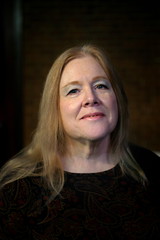Sally Cragin Interviews Robin Soans
Súgán brings Talking to Terrorists to America
By: SALLY CRAGIN
3/9/2006 Boston Phoenix
Robin SoansTalking to Terrorists is a provocative title for a play. What’s more, that’s exactly what Robin Soans did to research his two-act documentary drama. The play earned rave reviews in its 2005 London debut from Out of Joint Theatre Company and the Royal Court. Starting next Friday, Boston’s Súgán Theatre Company offers the American premiere.
Soans condensed hundreds of hours of interviews, many of which he conducted himself, into an unusual theatrical collage. Former members of various outlaw groups including the IRA, Uganda’s National Resistance Army, and the Palestinian Al-Aqsa Martyrs Brigade tell their stories, which include graphic anecdotes and surprising psychological revelations.
Súgán will field eight actors, each playing three to five characters that range from terrorists to victims to diplomats to ambassadors. “It’s ‘verbatim theater,’ ” explains director Carmel O’Reilly. “The script covers Africa, Iraq, Northern Ireland, and the Palestinian situation. These are the voices that are not heard.”
But Soans, who is also an actor and the author of an earlier play on a similar topic called The Arab-Israeli Cookbook , was listening. He was able to make contact with terrorists living in the West through Scilla Elworthy, a Nobel-nominated trustee for the international organization Peace Direct. He began paying visits to the world’s least-loved criminals.
“I want to know who they are and where they came from,” he explains over the phone from London. “The first real thing we discovered is just how young people are when they become involved. The syndromes that are forming their opinions happen at a very impressionable period of their life. I suppose I’m saying, if I had grown up in the same set of circumstances, I’m not sure I wouldn’t have ended up doing the same thing myself.”
Rather than romanticizing his renegades, Soans “began to see patterns” in their stories. Still, early drafts showed that “the play was a bit one-sided, and the terrorists I talked to appeared rather heroic.” In the second act of the final version, he creates from transcripts a dynamic dialogue between a victim of the 1984 Brighton hotel bombing on one side of the stage and the bomber on the other. “You have to realize they fight for an idea — but that idea requires that others have their lives mangled.”
Soans admits that he edits for “maximum theatrical effect” and that he’s discarded plenty of graphic and disturbing scenes that didn’t necessarily advance the narrative. “My chief aim is to give voice to people who don’t have a voice in the theater. But my interest is purely humanitarian. I’m simply interested in the human condition — anything that helps us understand the human condition better.”
By: SALLY CRAGIN
3/9/2006 Boston Phoenix
Robin SoansTalking to Terrorists is a provocative title for a play. What’s more, that’s exactly what Robin Soans did to research his two-act documentary drama. The play earned rave reviews in its 2005 London debut from Out of Joint Theatre Company and the Royal Court. Starting next Friday, Boston’s Súgán Theatre Company offers the American premiere.
Soans condensed hundreds of hours of interviews, many of which he conducted himself, into an unusual theatrical collage. Former members of various outlaw groups including the IRA, Uganda’s National Resistance Army, and the Palestinian Al-Aqsa Martyrs Brigade tell their stories, which include graphic anecdotes and surprising psychological revelations.
Súgán will field eight actors, each playing three to five characters that range from terrorists to victims to diplomats to ambassadors. “It’s ‘verbatim theater,’ ” explains director Carmel O’Reilly. “The script covers Africa, Iraq, Northern Ireland, and the Palestinian situation. These are the voices that are not heard.”
But Soans, who is also an actor and the author of an earlier play on a similar topic called The Arab-Israeli Cookbook , was listening. He was able to make contact with terrorists living in the West through Scilla Elworthy, a Nobel-nominated trustee for the international organization Peace Direct. He began paying visits to the world’s least-loved criminals.
“I want to know who they are and where they came from,” he explains over the phone from London. “The first real thing we discovered is just how young people are when they become involved. The syndromes that are forming their opinions happen at a very impressionable period of their life. I suppose I’m saying, if I had grown up in the same set of circumstances, I’m not sure I wouldn’t have ended up doing the same thing myself.”
Rather than romanticizing his renegades, Soans “began to see patterns” in their stories. Still, early drafts showed that “the play was a bit one-sided, and the terrorists I talked to appeared rather heroic.” In the second act of the final version, he creates from transcripts a dynamic dialogue between a victim of the 1984 Brighton hotel bombing on one side of the stage and the bomber on the other. “You have to realize they fight for an idea — but that idea requires that others have their lives mangled.”
Soans admits that he edits for “maximum theatrical effect” and that he’s discarded plenty of graphic and disturbing scenes that didn’t necessarily advance the narrative. “My chief aim is to give voice to people who don’t have a voice in the theater. But my interest is purely humanitarian. I’m simply interested in the human condition — anything that helps us understand the human condition better.”


0 Comments:
Post a Comment
<< Home